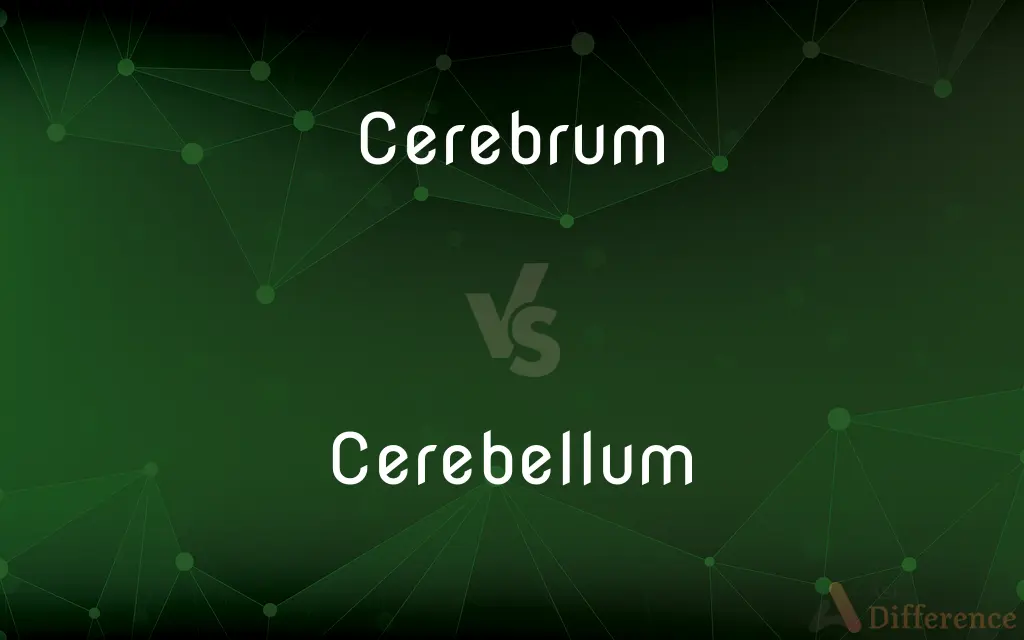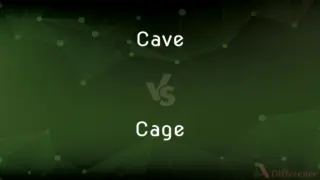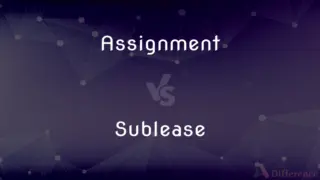Cerebrum vs. Cerebellum — What's the Difference?
By Tayyaba Rehman — Updated on September 22, 2023
The cerebrum is the brain's largest part, handling cognition, sensation, and voluntary motion. The cerebellum, located below and behind the cerebrum, regulates coordination and balance.

Difference Between Cerebrum and Cerebellum
Table of Contents
ADVERTISEMENT
Key Differences
The cerebrum and cerebellum are vital components of the brain, each serving distinct functions. The cerebrum, the most prominent part of the human brain, is responsible for thought processes, feelings, and voluntary muscle movements. It's where sensory information is processed, allowing humans to see, hear, and touch.
In contrast, the cerebellum, positioned under the cerebrum at the brain's back, plays a key role in motor control. It doesn't initiate movement, but it fine-tunes motor activities, ensuring smooth, coordinated actions. Every time you walk, dance, or catch an object, the cerebellum is actively refining those motions.
Both the cerebrum and cerebellum are divided into two hemispheres. The cerebrum's hemispheres are linked by the corpus callosum, enabling communication between the left and right sides. This part of the brain is also the site of the cerebral cortex, which houses higher-order functions like reasoning, language, and problem-solving.
The cerebellum's hemispheres help coordinate movement for the body's corresponding side. It fine-tunes muscular actions, using feedback from the body to maintain posture, balance, and other aspects of motor control. Despite being smaller than the cerebrum, the cerebellum contains more neurons, highlighting its complexity and essential role.
Together, the cerebrum and cerebellum allow for a wide range of human experiences, from deep thought and communication to gracefully executed physical movements.
ADVERTISEMENT
Comparison Chart
Location
Upper part of the brain
Below and behind the cerebrum
Primary Functions
Cognition, sensation, voluntary movement
Coordination, balance, fine-tuning movement
Hemispheres
Two (left and right), connected by the corpus callosum
Two (left and right)
Size
Larger part of the brain
Smaller but densely packed
Neurons
Fewer in number
Contains more neurons
Compare with Definitions
Cerebrum
The brain's principal part for thought and action.
Her cerebrum is active when solving mathematical problems.
Cerebellum
Brain's section fine-tuning motor movements.
The cerebellum helps dancers move with precision.
Cerebrum
Region of the brain governing voluntary muscle activity.
When she decided to move her hand, her cerebrum was at work.
Cerebellum
Responsible for balance and coordination.
Gymnasts rely heavily on their cerebellum for intricate routines.
Cerebrum
The brain's outermost layer, encompassing the cerebral cortex.
The wrinkles and folds we associate with the brain are features of the cerebrum.
Cerebellum
Positioned beneath the cerebrum, at the brain's back.
The cerebellum's location is distinct from the brain's main lobes.
Cerebrum
Brain's section processing sensory inputs.
Taste, sight, and smell are processed in the cerebrum.
Cerebellum
Plays a role in refining actions based on feedback.
When adjusting posture, the cerebellum processes the changes.
Cerebrum
The site of intelligence, creativity, and emotion.
The cerebrum allows for artistic expression and deep emotion.
Cerebellum
Contains a massive number of neurons despite its size.
The cerebellum's dense structure aids in its motor functions.
Cerebrum
The cerebrum, telencephalon or endbrain, is the largest part of the brain containing the cerebral cortex (of the two cerebral hemispheres), as well as several subcortical structures, including the hippocampus, basal ganglia, and olfactory bulb. In the human brain, the cerebrum is the uppermost region of the central nervous system.
Cerebellum
The cerebellum (Latin for "little brain") is a major feature of the hindbrain of all vertebrates. Although usually smaller than the cerebrum, in some animals such as the mormyrid fishes it may be as large as or even larger.
Cerebrum
The large rounded structure of the brain occupying most of the cranial cavity, divided into two cerebral hemispheres that are joined at the bottom by the corpus callosum. It controls and integrates motor, sensory, and higher mental functions, such as thought, reason, emotion, and memory.
Cerebellum
The trilobed structure of the brain, lying posterior to the pons and medulla oblongata and inferior to the occipital lobes of the cerebral hemispheres, that is responsible for the regulation and coordination of complex voluntary muscular movement as well as the maintenance of posture and balance.
Cerebrum
(neuroanatomy) The principal and most anterior part of the brain in vertebrates, which is located in the front area of the skull and divided into two hemispheres, left and right, separated by a fissure. In humans it is the largest part of the brain and is responsible for the integration of complex sensory functions and the initiation and coordination of voluntary activity, and the higher mental functions such as consciousness, thought, reason, emotion, and memory.
Cerebellum
(neuroanatomy) Part of the hindbrain in vertebrates. In humans it lies between the brainstem and the back of the cerebrum and is formed of two lateral lobes and a median lobe. It plays an important role in sensory perception, motor output, balance and posture.
Cerebrum
The anterior, and in man the larger, division of the brain; the seat of the reasoning faculties and the will. See Brain.
Cerebellum
The large lobe of the hind brain in front of and above the medulla; the little brain. It controls combined muscular action. See Brain.
Cerebrum
Anterior portion of the brain consisting of two hemispheres; dominant part of the brain in humans
Cerebellum
A major division of the vertebrate brain; situated above the medulla oblongata and beneath the cerebrum in humans
Common Curiosities
Can damage to the cerebellum affect balance?
Yes, cerebellum damage can impair balance, coordination, and refined movements.
Do both the cerebrum and cerebellum deal with movement?
Yes, the cerebrum initiates voluntary movement, while the cerebellum fine-tunes it.
Which part of the brain is larger?
The cerebrum is larger and occupies most of the brain's volume.
Which part processes language and problem-solving?
The cerebrum, particularly the cerebral cortex, manages language and higher-order thinking.
Where is the cerebellum located?
The cerebellum is located beneath and behind the cerebrum.
What cognitive functions does the cerebrum manage?
The cerebrum handles thought processes, creativity, emotions, and sensory processing.
Do both have distinct hemispheres?
Yes, both the cerebrum and cerebellum have left and right hemispheres.
Which part of the brain is active during deep reflection?
The cerebrum is active during deep thought and reflection.
What connects the cerebrum's hemispheres?
The corpus callosum connects the cerebrum's two hemispheres.
Where is sensory information like taste processed?
Sensory information, including taste, is primarily processed in the cerebrum.
Is the cerebellum involved in emotion?
While primarily known for motor control, the cerebellum might have roles in emotion and cognition.
How does the cerebellum aid in motor skills?
It refines motor activities, ensuring smooth, coordinated actions.
Why is the cerebellum so densely packed with neurons?
The cerebellum's neuron density supports its role in complex motor coordination.
Between the cerebrum and cerebellum, which has more neurons?
Despite its smaller size, the cerebellum contains more neurons than the cerebrum.
How does the cerebellum impact athletic abilities?
Athletes rely on the cerebellum for balance, precision, and coordinated movements.
Share Your Discovery

Previous Comparison
Restructuring vs. Reorganization
Next Comparison
Cave vs. CageAuthor Spotlight
Written by
Tayyaba RehmanTayyaba Rehman is a distinguished writer, currently serving as a primary contributor to askdifference.com. As a researcher in semantics and etymology, Tayyaba's passion for the complexity of languages and their distinctions has found a perfect home on the platform. Tayyaba delves into the intricacies of language, distinguishing between commonly confused words and phrases, thereby providing clarity for readers worldwide.















































